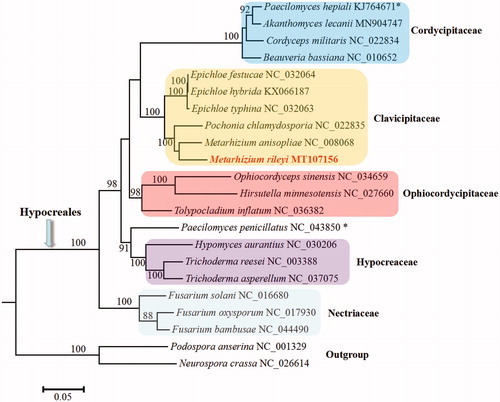Abstract
In this study, the complete mitogenome of an entomopathogenic fungus Metarhizium rileyi was assembled and annotated. This circular mitogenome was 62,514 bp in length and consisted of 2 rRNA genes, 25 tRNA genes, 14 standard protein-coding genes of the oxidative phosphorylation system, and seven intergenic ORFs. Seven genes were invaded by a total of 22 introns, including atp9 (1), cob (4), cox1 (8), cox3 (2), nad1 (1), nad5 (3), and rnl (3 introns). These introns all belonged to the group I intron family but fell into four specific subgroups. Phylogenetic analysis based on mitochondrial nucleotide sequences confirmed M. rileyi in the family Clavicipitaceae, being most close to Metarhizium anisopliae.
Metarhizium rileyi, formerly known as Nomuraea rileyi (Kepler et al. Citation2014), is a cosmopolitan species of entomopathogenic fungi within the family Clavicipitaceae (Hypocreales, Ascomycota). It has a much more limited host range than Metarhizium anisopliae and is able to cause large epizootic events against lepidopteran hosts almost totally limited to species of the family Noctuidae. The nuclear genome of M. rileyi has been reported using the strain RCEF 4871 (Shang et al. Citation2016). Nevertheless, the mitogenome information of the fungus is still lacking. Herein, we present the complete mitogenome of M. rileyi RCEF 4871. This strain was isolated from a lepidopteran larva of Noctuidae in Xiaozhi, Pingyin, Shandong, China (N36°06′, E116°26′) and was deposited in the culture collection of the Research Center on Entomogenous Fungi (RCEF), Anhui Agricultural University, Hefei, China.
Total DNA of RCEF 4871 was fragmented by sonication to a size of ∼280 bp, followed by sequencing on an Illumina NovaSeq platform in 2 × 150 bp reads. Mitogenome was de novo assembled from clean reads using NOVOPlasty (Dierckxsens et al. Citation2017) and then annotated as described previously (Zhang et al. Citation2017). Introns were named according to a newly suggested nomenclature (Zhang and Zhang Citation2019).
The mitogenome of M. rileyi (GenBank accession: MT107156) was a circular molecule of 62,514 bp with an AT content of 73.58%. This mitogenome encoded two ribosomal RNAs (rnl and rns), 25 tRNAs, 14 conserved proteins of the oxidative phosphorylation system (nad1-6, 4 L; cob; cox1-3, and atp6, 8, 9), and seven intergenic ORFs. These tRNA genes coded for all 20 standard amino acids. These intergenic ORFs encoded either GIY-YIG endonucleases or hypothetical proteins.
Seven genes were invaded by a total of 22 introns, including atp9 (1), cob (4), cox1 (8), cox3 (2), nad1 (1), nad5 (3), and rnl (3 introns). These introns all belonged to the group I intron family but fell into four specific subgroups, naming IA (4 introns), IB (14), IC2 (1), and ID (3). Except for two introns (mL965 and nad5P426), other introns all contained putative ORFs encoding for ribosomal protein S3, LAGLIDADG/GIY-YIG homing endonucleases, or hypothetical proteins. The two ORF-lacking introns might be degenerating due to either frame shifts or stop codon mutations.
Phylogenetic analysis based on mitochondrial nucleotide sequences confirmed M. rileyi as a member in Clavicipitaceae (). The fungus was closely related to Metarhizium anisopliae though their clustering failed to receive strong support. All species used in this study clustered based on their family-level affiliations, with two exceptions. The placement of Paecilomyces penicillatus and Paecilomyces hepiali was variable in different taxonomic databases: Clavicipitaceae in Hypocreales in the NCBI taxonomy, Aspergillaceae in Eurotiales in Species Fungorum, and Trichocomaceae in Eurotiales in Mycobank. Our phylogenetic analysis supported the placement of both species in Hypocreales but P. penicillatus seemed to have affinities to Hypocreaceae rather than Clavicipitaceae and P. hepiali clustered in Cordycipitaceae (). The genus Paecilomyces sensu lato was polyphyletic as those depicted earlier (Luangsa-ard et al. Citation2004, Citation2005).
Figure 1. Phylogenetic analysis of Hypocreales species based on mitochondrial nucleotide sequences. We used all species of Clavicipitaceae and representative species of all other families with available mitogenomes in Hypocreales. Two Sordariales species (Podospora anserine and Neurospora crassa) were used as outgroups. The whole mitogenome sequences (or exonic sequences in cases with alignment difficulties) of these species were aligned and trimmed using the HomBlocks pipeline (Bi et al. Citation2018), resulting in an alignment of 7193 characters. Phylogenetic reconstruction was performed using the maximum likelihood approach as implemented in RAxML v8.2.12 (Stamatakis Citation2014). Support values were given for nodes that received bootstrap values ≥ 70%. GenBank accession numbers followed after fungal taxon names. The asterisk (*) indicates fungal taxa with controversial taxonomy in different databases.

Declaration of interest
The authors report no conflicts of interest. The authors alone are responsible for the content and writing of the article.
Additional information
Funding
References
- Bi G, Mao Y, Xing Q, Cao M. 2018. HomBlocks: a multiple-alignment construction pipeline for organelle phylogenomics based on locally collinear block searching. Genomics. 110(1):18–22.
- Dierckxsens N, Mardulyn P, Smits G. 2017. NOVOPlasty: de novo assembly of organelle genomes from whole genome data. Nucleic Acids Res. (4):e18.
- Kepler RM, Humber RA, Bischoff JF, Rehner SA. 2014. Clarification of generic and species boundaries for Metarhizium and related fungi through multigene phylogenetics. Mycologia. 106(4):811–829.
- Luangsa-Ard JJ, Hywel-Jones NL, Manoch L, Samson RA. 2005. On the relationships of Paecilomyces sect. Isarioidea species. Mycol Res. 109(5):581–589.
- Luangsa-Ard JJ, Hywel-Jones NL, Samson RA. 2004. The polyphyletic nature of Paecilomyces sensu lato based on 18S-generated rDNA phylogeny. Mycologia. 96(4):773–780.
- Shang Y, Xiao G, Zheng P, Cen K, Zhan S, Wang C. 2016. Divergent and convergent evolution of fungal pathogenicity. Genome Biol Evol. 8(5):1374–1387.
- Stamatakis A. 2014. RAxML version 8: a tool for phylogenetic analysis and post-analysis of large phylogenies. Bioinformatics. 30(9):1312–1313.
- Zhang S, Zhang YJ. 2019. Proposal of a new nomenclature for introns in protein-coding genes in fungal mitogenomes. IMA Fungus. 10(1):15.
- Zhang YJ, Yang XQ, Zhang S, Humber RA, Xu JP. 2017. Genomic analyses reveal low mitochondrial and high nuclear diversity in the cyclosporin-producing fungus Tolypocladium inflatum. Appl Microbiol Biotechnol. 101(23–24):8517–8531.
